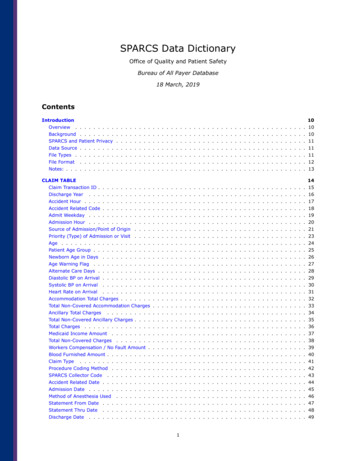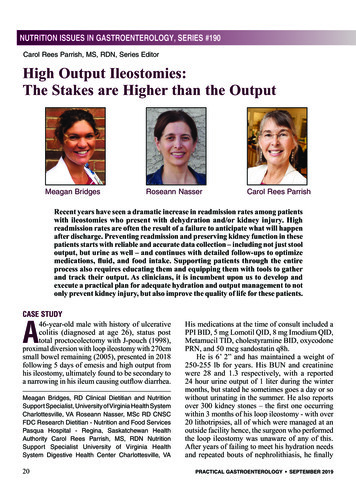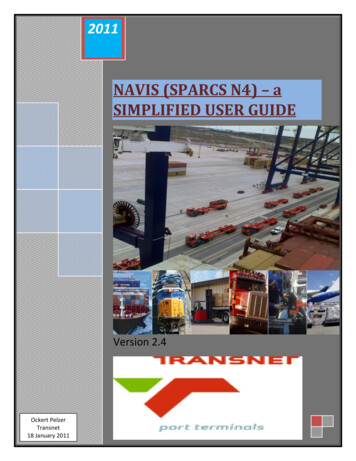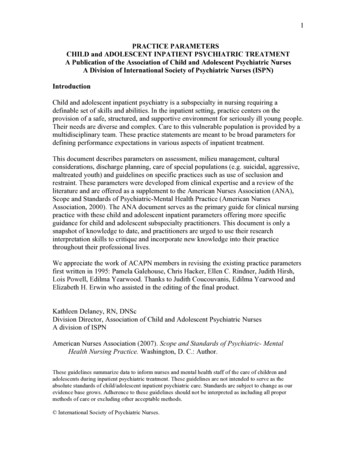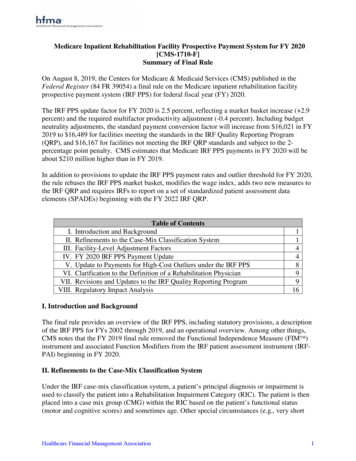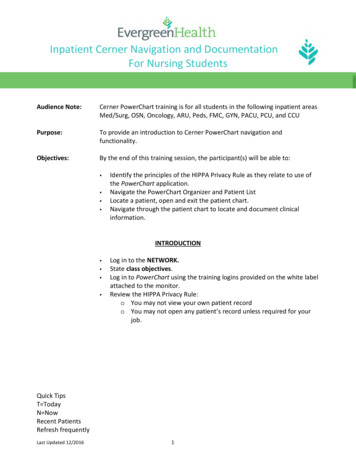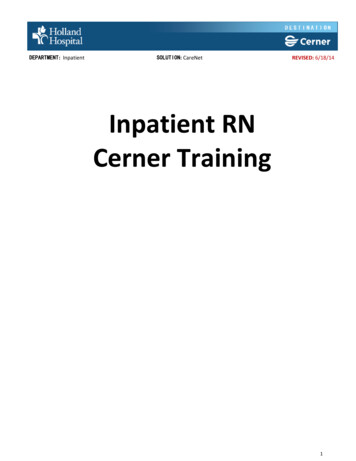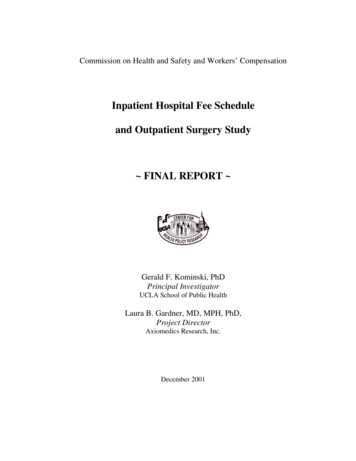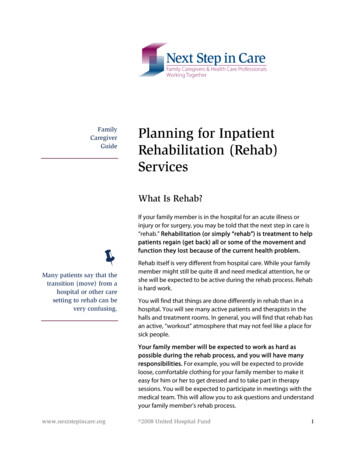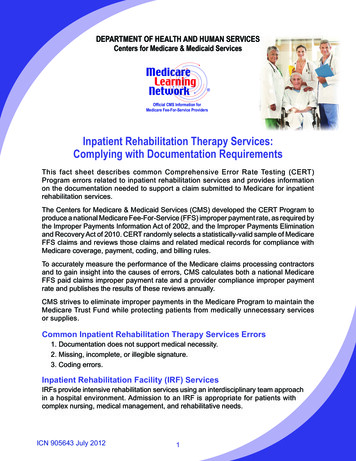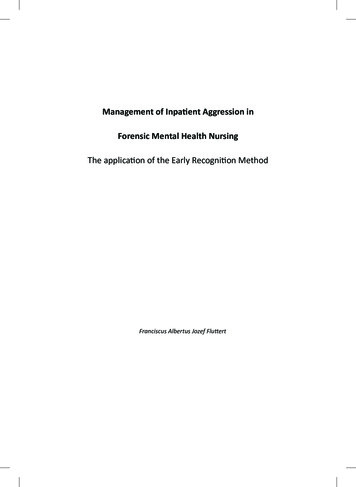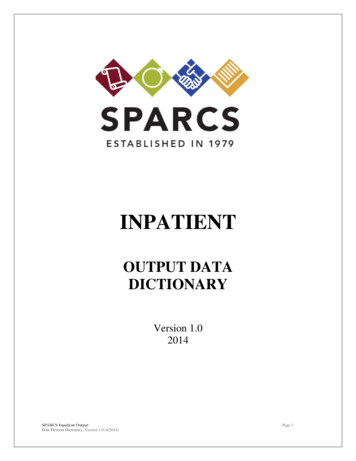
Transcription
INPATIENTOUTPUT DATADICTIONARYVersion 1.02014SPARCS Inpatient OutputData Element Dictionary, Version 1.0 (4/2014)Page 1
Prepared By:Bureau of Health InformaticsOffice of Quality and Patient SafetyNew York State Department of HealthPhone: (518) 474-3189E-mail: SPARCS@health.state.ny.usWebsite: .htmSPARCS Inpatient OutputData Element Dictionary, Version 1.0 (4/2014)Page 2
Table of ContentsNOTE: Bolded and UPPER CASE are IDENTIFYING DATA ELEMENTS (see Data Protection Review Board (DPRB)(See note below Regarding AIDS/HIV and Abortion Edits)Common DetailI. INTRODUCTION .Page9II. DATA ELEMENT GUIDE .17III. PRIMARY RECORDS .394040414243 .Discharge Sequential Number .Continuation Indicator . Record Sequence Number Record Sequence Count . Patient SegmentNewborn .PATIENT CONTROL NUMBER .MEDICAL RECORD NUMBER . .UNIQUE PERSONAL IDENTIFIER . .ENHANCED UNIQUE PERSONAL IDENTIFIER . .PATIENT BIRTH DATE Age .Age in Days (for Newborn) . Patient Sex Patient Race .Patient Ethnicity .PATIENT ADDRESS LINE 1 . .PATIENT ADDRESS LINE 2 . .Patient City . Patient State . Patient Postal Service Zip Code AND EXTENSION CODE .Patient County Code .SPARCS Region Code . 4445464850515253545556575859606162 .63636567Newborn Flag MOTHER'S MEDICAL RECORD NUMBER (for Newborn Child) Newborn Birth Weight (previously Neonate Birth Weight) .FacilityPhysician .Facility Identifier (previously SPARCS Identification Number) Facility Identifier Check Digit .Facility Name .Health Service Area .Facility County .Operating Certificate Number National Provider ID .6868697071727374 .75Attending Provider State License Number Operating Physician State License Number Other Operating Physician State License Number (previously Other Provider License757677SPARCS Inpatient OutputData Element Dictionary, Version 1.0 (4/2014)Page 3
Number) Payer .Source of Payment Typology 1 .Source of Payment Typology 2 .Source of Payment Typology 3 .Source of Payment 1-6 .Claim Filing Indicator Code 1-6 INSURED’S POLICY NUMBER 1-6 (previously Policy Number) .Payer ID Number 1-6 .Covered Days 1-6 . Non-Covered Days 1-6 . Billing Provider NPI 1-6 (previously Provider Identification Number). . Alternate Level of Care Days 1-6 . Leave of Absence (LOA) Days 1-6 . .Expected Principal Reimbursement .Expected Reimbursement Other 1 Expected Reimbursement Other 2 Worker’s Compensation/No Fault Indicator . Worker’s Compensation/No Fault Amount . Surplus, Catastrophic or Recurring Monthly Code .Surplus, Catastrophic or Recurring Monthly Amount .Data Collection .Log Number . .Transaction Code .Date Processed .SPARCS Collector Code . Claim Type . Source File Type .Miscellaneous .Residence Indicator . .Special Program (DIS) . .Special Program (FP) . Special Program (PHC) . Special Program (SFP) . .Old SPARCS Accommodation Codes 1-5 (prev. SPARCS Accommodation Codes) .Placement of Bed Indicator . .Do Not Resuscitate Indicator .Emergency Department Indicator . Exempt Unit Indicator Treatment STATEMENT FROM DATE (previously Statement Covers Period From Date STATEMENT THRU DATE (previously Statement Covers Period Thru Date) . ADMISSION DATE / START OF CARE DATE .Admit Weekday .Admission Hour . . Unscheduled/Scheduled Admission . .DISCHARGE DATE . Discharge Weekday .Discharge Hour Length of Stay . .SPARCS Inpatient OutputData Element Dictionary, Version 1.0 116117117119120122123124125126127128Page 4
DiagnosisInsured Days . Non-Insured Days .Total Leave of Absence Days Total Alternate Care Days . Type of Alternate Care Required . DATE ALTERNATE CARE REQUIRED . Total Acute Certified Days Non-Acute Care Type 1-30 NON-ACUTE FROM DATE 1-30 .NON-ACUTE THROUGH DATE 1-30 . . Same Day Discharge Indicator .Patient Discharge Status (previously NYS Patient Status orDisposition) . . Type of Bill Service Category Group Type of Admission . Point of Origin (previously Source of Admission) . 129130131132133134135136137139141 .148148149151153155156157158159160Admitting Diagnosis Code . Principal Diagnosis Code . .Other Diagnosis Code 1-24 . .Present on Admission (POA) Indicator 1-24 .Clinical Classification Software (CCS) Diagnosis Category . After Anesthesia Indicator 1-14 . Accident Related Code . ACCIDENT RELATED DATE . External Cause of Injury Place of Injury Code . Procedure . .Principal Procedure Code . PRINCIPAL PROCEDURE DATE . Pre-Admit Procedure Indicator 1-15 (previously Pre-Admit Indicator) .Pre-Op Days 1-15 .Post-Op Days 1-15 . Other Procedure Code 1-14 . .OTHER PROCEDURE DATE 1-14 .Clinical Classification Software (CCS) Procedure Category Method of Anesthesia Used .Blood Furnished Amount . Age Warning Flag . Procedure Date Warning Flag Procedure Coding Method DRGs .Federal Diagnostic Risk Grouper (DRG) .Federal Major Diagnostic Category (MDC) . Past Federal Diagnosis Related Group (Past DRG)(previously DRG Prior Federal) .Past Federal Major Diagnostic Category (Past MDC)(previously MDC Prior Federal) .New Federal Diagnostic Related Group (New DRG) New Federal Major Diagnostic Category (New MDC) . All Patient Diagnosis Related Group (AP DRG) . SPARCS Inpatient OutputData Element Dictionary, Version 1.0 170171172173174175175176177178179180181Page 5
AMIAll Patient Major Diagnostic Category (AP MDC) . Past All Patient Diagnostic Related Group (AP DRG) .Past All Patient Major Diagnostic Category (AP MDC) .New All Patient Diagnosis Related Group (AP DRG) .New All Patient Major Diagnostic Category (AP MDC) . All Patient Refined Diagnosis Related Group (APR DRG) . All Patient Refined Major Diagnostic Category (APR MDC) . All Patient Refined Risk of Mortality (APR ROM) .All Patient Refined Severity of Illness (APR SOI) . .Past All Patient Refined Diagnosis Related Group (APR DRG) .Past All Patient Refined Major Diagnostic Category (APR MDC) .Past All Patient Refined Risk of Mortality (APR ROM) .Past All Patient Refined Severity of Illness (APR SOI) . .New All Patient Refined Diagnosis Related Group (APR DRG) . .New All Patient Refined Major Diagnostic Category (APR MDC) .New All Patient Refined Risk of Mortality (APR ROM) .New All Patient Refined Severity of Illness (APR SOI) . Diagnosis Related Group (DRG) Billed 8199 .200200201202203AMI Warning Flag .Heart Rate on Arrival .Systolic BP on Arrival . Diastolic BP on Arrival .HIPPAA .AIDS / HIV Flag . .Abortion Flag .ChargesService .Total Charges Total Accommodation Charges .Ancillary Total Charges . Total Non-Covered Charges .Total Non-Covered Accommodation Charges .Total Non-Covered Ancillary Charges . .206206207208209210211 .212Revenue Code 1-10 (previously UB-92 Accommodation Code and Inpatient AncillaryRevenue Code) .Revenue Type 1-10 .Service Charge 1-10 . .Unit Type 1-10 Unit Quantity 1-10 .Non-Covered Charges 1-10 . .212214215216217220IV. CONTINUATION RECORDSCommon Detail204204205 .Discharge Sequential Number .Continuation Indicator .Record Sequence Number . Record Sequence Count SPARCS Inpatient OutputData Element Dictionary, Version 1.0 (4/2014)220221221222223224Page 6
Service . .Revenue Code 11-80 (previously UB-92 Accommodation Code and InpatientAncillary Revenue Code .Revenue Type 11-80 .Service Charge 11-80 (previously Accommodation Total Charges andInpatient Ancillary Total Charges) .Unit Type 11-80 .Unit Quantity 11-80 . .Non-Covered Charges 11-80(previously Accommodation Total Non-CoveredCharges and Inpatient Ancillary Total Non-covered Charges V. APPENDICES LISTING .SPARCS Inpatient OutputData Element Dictionary, Version 1.0 (4/2014)225225227228229230232234Page 7
I.INTRODUCTIONSPARCS Inpatient OutputData Element Dictionary, Version 1.0 (4/2014)Page 8
I. IntroductionOVERVIEWThe Statewide Planning and Research Cooperative System (SPARCS) is a comprehensive datareporting system established in 1979 as a result of cooperation between the health care industryand government to collect patient level detail on patient characteristics, diagnoses, treatmentsand services. The purpose of SPARCS, as outlined in the regulations, was to create a statewidedata set to contribute to the goal of providing high quality medical care at a reasonable cost to theinhabitants of the State by serving as an information source for organizations and agenciesseeking to promote the efficient delivery of health care services. (Title 10 (Health) NYCRR400.18 (e)(1)(i)).Initially, data was collected for inpatient discharges only; SPARCS now collects data for everyinpatient hospital discharge (IP)(1980), ambulatory surgery visit (AS)(1983),emergencydepartment admission (ED) (2003), and most recently, outpatient visits (OP) (2011) from healthcare facilities certified under Article 28 of the New York State Public Health Law (NYSPHL).The enabling legislation and regulations for SPARCS are located under Section 2816 of thePublic Health Law and Section 400.18 of Title 10 (Health) of the Official Compilation of Codes,Rules, and Regulations of the State of New York (NYCRR).BACKGROUNDThe NYS Department of Health Office of Health Systems Management received grant fundingfrom the Health Care Financing Administration (HCFA) in October, 1977. After establishing thenecessary forms, procedures, and involvement of the health care community, data collectionbegan in 1979 as a demonstration project.In 1980, the first regulations were established in the Title 10 NYCCR to continue SPARCSunder regulatory authority to collect inpatient data. The regulations required that inpatient databe submitted by all Article 28 facilities certified for inpatient services in New York State.In April 1983 and June 1985, the State Hospital Review and Planning Council adopted additionalregulations authorizing the reporting of ambulatory surgery data (AS) to the New York StateDepartment of Health. These additional regulations required that outpatient data be submitted byall facilities providing ambulatory surgery services.In April 1993, a national ad hoc task force released a new Universal Data Set (UDS)Specification that included reporting codes for use with the Uniform Bill (UB-92) paper formand a new electronic format. The UDS system streamlined multiple data submission formats intoa single format, removing redundant reporting requirements for hospitals and other health carefacilities. SPARCS adopted these national formats for billing and claims processing to simplifydata reporting With this adoption, SPARCS reaped the benefits of using the national standards;In order to continue to progress with the current health care industry data standards, SPARCScontinues to adopt changes approved by the National Uniform Billing Committee (NUBC).Recognizing the need for emergency department data (ED), the New York State Legislaturepassed legislation in September 2001 mandating the collection of ED data through SPARCS.After identifying data elements that satisfied public health and health services administrationSPARCS Inpatient OutputData Element Dictionary, Version 1.0 (4/2014)Page 9
information needs, voluntary submissions started in 2003. Once the regulations were establishedfor the collection of ED data in January 2005, mandatory collection began.In April 2006 the New York State Legislature again amended Article 28 Section 2816 (2) (a) (iv)to mandate the reporting of all outpatient clinic visit data (OP). This new information was addedto the collection of AS and ED visits on the outpatient file. This initiative became known as theExpanded Outpatient Data Collection (EODC) Project with data collection commencing with aphased in approach that started in the summer of 2011 from hospital outpatient departments. Thisnew information was added to the Outpatient Output SPARCS file.As a result of the new data collection, the need arose to restructure the output files. In 2012 thestructure of the output files for both the inpatient and outpatient data were modified to organizethe data elements into segments. This document reflects these changes.SPARCS AND PATIENT PRIVACYThe responsibility for protecting the confidentiality and privacy of data related to patient careresides with the Commissioner of Health. The responsibility for tracking and monitoring thetechnical functioning of SPARCS data collection resides within the Bureau of HealthInformatics. Staff is available to assist with every phase of the SPARCS data system.As a public health entity, the NYS Department of Health and the SPARCS data set are notcovered under the Health Insurance Portability and Accountability Act (HIPAA) of 1996.However, the NYS Department of Health takes very seriously the protection of patient privacy.In fact, the NYS Department of Health created a Data Protection Review Board (DPRB) that hasbeen in place since 1980. The DPRB approves the applications for identifiable data.All users of the SPARCS Limited and Identifiable data must sign Data Use Agreements (DUAs).Regardless of the type of data or file being used, these DUAs are strictly enforced.WHERE THE DATA COMES FROM:SPARCS inpatient (IP) and outpatient (AS, ED, OP) data is provided by facilities certified underArticle 28 of the Public Health Law. Any facility certified to provide inpatient services,ambulatory surgery services, emergency department services or outpatient services is required tosubmit data to SPARCS. This includes all New York State Hospitals and Diagnostic andTreatment Centers (D&TC’s - commonly known as clinics). This includes both hospital ownedand operated, as well as free-standing D&TC facilities. Regardless of their ownership, eachfacility must report data for each specific facility location. That is, if a hospital owns more thanone location (i.e., Buffalo General Hospital, Millard Fillmore Hospital, Millard FillmoreSuburban, and DeGraff Memorial Hospital) each location must report separately to SPARCS.SPARCS Inpatient OutputData Element Dictionary, Version 1.0 (4/2014)Page 10
FILE TYPES and FORMATSPARCS data users will find a vast array of information on our web site including specifics ondata content, format, and obtaining data access. Users should note the distinction between thetwo Output Data Dictionaries (Inpatient and Outpatient). The Output Data Dictionary forInpatient (hospital discharge data and emergency room visits that resulted in an inpatient staydata) and the Output Data Dictionary for Outpatient (emergency department only, ambulatorysurgery, and outpatient services visit data) are two specific documents for data users.With the collection of new outpatient services data in 2012, came the opportunity to redesign theoutput files. Beginning in August 2012, the file format for all data years (for all types of data)was modified. For SPARCS data users that obtained data prior to August 2012, this DataDictionary will not apply since data was in the old format. For users obtaining data in August2012 and after, (for any data year) this Data Dictionary will apply since the data is in the newformat. Thus, if you requested Inpatient Data for years 2000-2005 after August 2012, this is theData Dictionary to use for the new file format. Any file received after August 2012 will be inthis new format, regardless of the year of data requested.File Types:To enable the use of SPARCS data as a national information resource for all researchers tocontribute to the goal of providing high quality medical care at a reasonable cost, there are threedistinct files available for usage. Additional information on these data sets is available on theNYS Health Department’s website at ntified – This data file contains basic record level detail; it does not contain datathat is protected health information (PHI) under HIPAA. The health information is notindividually identifiable;
SPARCS Inpatient Output Page 9 Data Element Dictionary, Version 1.0 (4/2014) I. Introduction OVERVIEW The Statewide Planning and Research Cooperative System (SPARCS) is a comprehensive data reporting system established in 1979 as
